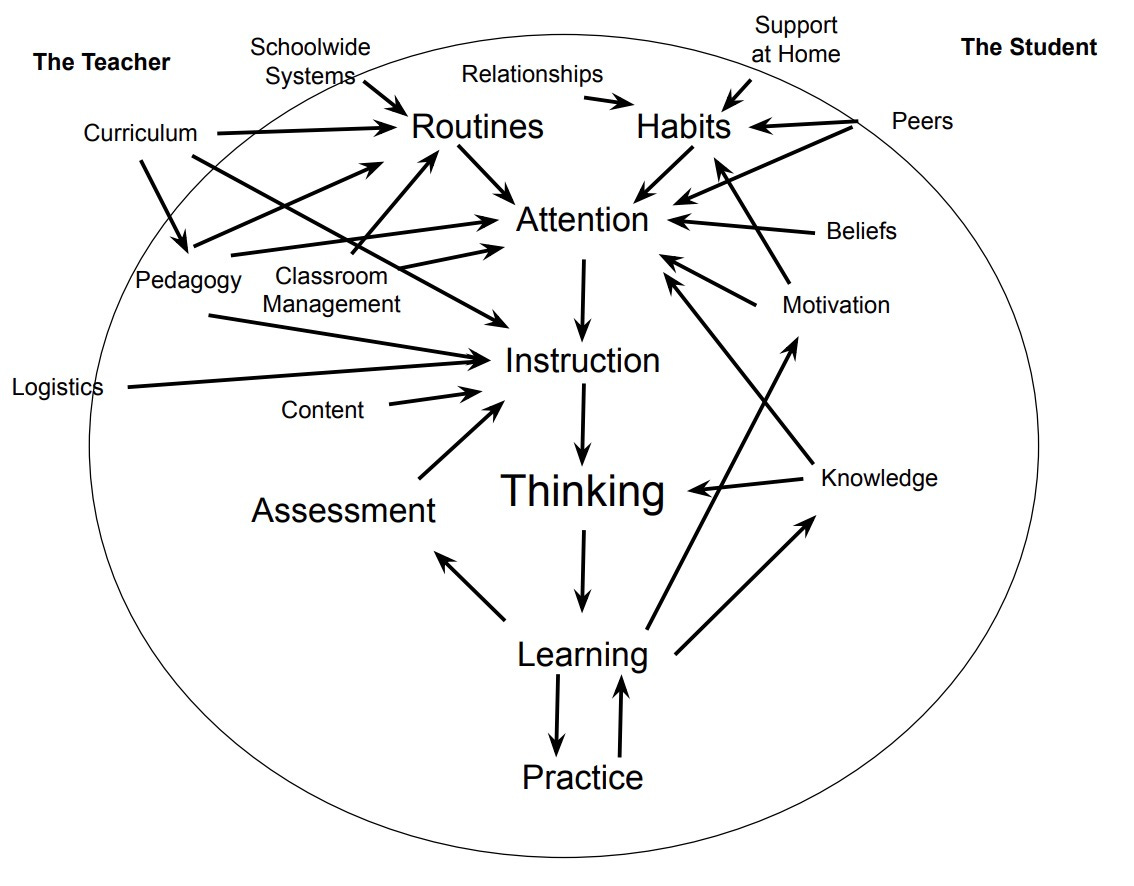I wrote last week about how there’s a lot of shallow thinking in education. A lot of “oh, you should do x” without understanding the context of that teacher’s classroom, how that advice fits into what the teacher is already doing and what the class culture looks like. You should go read it.
As a follow-up, I want to share a very rough diagram of how I think about classroom learning. It’s not meant to be a definitive, perfect map. This was mostly a fun exercise for me to think through how learning happens and how complex classrooms are. Anyway, here it is:
A few notes:
Everything inside the circle represents things the teacher has some control over. The teacher/school elements are on the left, and the student elements are on the right.
There’s a core sequence: attention → instruction → thinking → learning (→ practice → back to learning). This is the heart of teaching. We get students to pay attention to something (could be the teacher, or a task, or a peer), that instruction drives thinking, thinking becomes learning, and practice reinforces the learning.
Thinking is key. If students aren’t thinking, they aren’t learning.
Habits (of students) and routines (engineered by teachers) drive a huge part of classroom learning. If you’re observing a lesson and wondering why something happened the way it did, most of the time it’s because of a routine or a habit. Routines and habits can be good and bad.
Assessment completes the loop: learning informs assessment, assessment informs instruction, and the cycle continues.
Most elements flow through attention, but attention is pretty far from learning. Attention matters, and there are lots of reasons that students might end up not paying attention. But attention for the sake of attention won’t get you very far.
Learning loops around. Learning informs assessment, and it can also feed student knowledge and motivation, which become assets for learning in the future.
Curriculum, pedagogy, and classroom management have a lot of outgoing arrows. These matter a lot. If other stuff is a mess they’re not going to do much, but they can also have a big influence in the right context.
Some things are outside of teachers’ control. That’s the stuff outside the circle. These things matter, absolutely. But there’s not too much we can do about them. Best to focus on what’s inside our sphere of influence.
This diagram isn’t exhaustive. I could put a ton more in, both new factors and more arrows, but they would get smaller and smaller. I think what’s in the diagram are the most important levers to pull to improve teaching and learning.
What’d I miss?



What do the arrows mean? Normally an arrow means ‘leads to’ or ‘is necessary for’. In your diagram I have no idea how to read it!
Excellent post (as usual) Dylan! And you didn't miss much...
I'd add in a little loop on the left side between Pedagogy, Content, and add "Tools" since those 3 things are the crux of how teachers build their lessons. What content do I want to cover, what tools do I have to do it (including technology but not limited to it) and what pedagogical methods will help me do it.
I'm thinking about the "Pedagogical Content Knowledge" used by Deborah Ball & others.